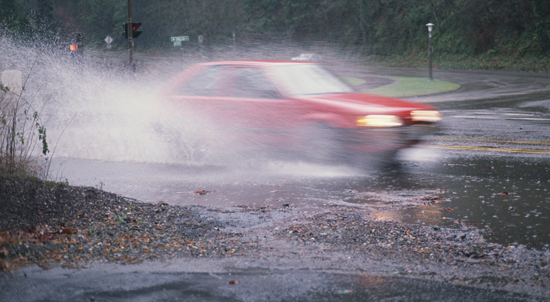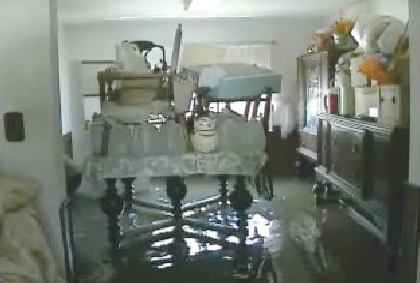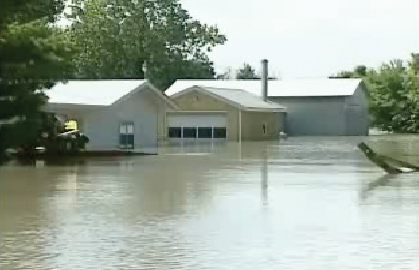
PROTECT YOURSELF WITH FLOOD INSURANCE

This year, we have already had historic, devastating damage to property by storms and floods..
Just a few inches of water from a flood can cause tens of thousands of dollars in damages. Over the past 10 years the average flood claim has amounted to over $33,000. Flood insurance is the best way to protect yourself from devastating financial loss.
Flood insurance is available to homeowners, renters, condo owners/renters, and commercial owners/renters. Costs vary depending on how much insurance is purchased, what it covers, and the property’s flood risk.
All policy forms provide coverage for buildings and contents. However, you might want to discuss insuring personal property with your agent since contents coverage is optional. Typically, there’s a 30 day waiting period from date of purchase before your policy goes into effect. That means now is the best time to buy flood insurance. In most cases there is NO coverage for flood damages under a Homeowners policy.
Flood insurance policies are continuous, and are not non-renewed or cancelled for repeat losses. Flood insurance reimburses you for all covered losses up to $250,000 for homeowners.
The average cost of a $100,000 flood policy is a little more than $400 annually, or just over one dollar per day. The cost of a $50,000 flood policy may be as low as $180 annually depending on where you live, or less than 50 cents per day.
Most homeowners insurance does not cover flood damage:
It takes 30 days after purchase for a policy to take effect, so it’s important to buy insurance before the floodwaters start to rise.
Your home has a 26% chance of being damaged by a flood during the course of a 30 year mortgage compared to a 9% chance of fire.
What is a Flood?
Anywhere it rains it can flood. A flood is a general and temporary condition where two or more acres of normally dry land or two or more properties are inundated by water or mudflow. Many conditions can result in a flood:
Just because you haven’t experienced a flood in the past doesn’t mean you won’t in the future. Flood risk isn’t just based on history it’s also based on a number of factors:
Flood
A general and temporary condition of partial or complete inundation of two or more acres of normally dry land area or of two or more properties, at least one of which is the policyholder’s property, from one of the following:
What’s Covered
Flood insurance policies cover physical damage to your
property and possessions.
Building Property
Personal Contents Property
What’s Not Covered
Flood policies do not insure for loss to property caused directly by earth movement even if the earth movement is caused by flood. Some examples of earth movement that we do not cover are:
- Earthquake, landslide, land subsidence; sinkholes;
- Destabilization or movement of land that results from accumulation of water in area or gradual erosion.
Flood policies do not insure for direct physical loss caused by any of the following:
- Theft, fire, explosion, wind or windstorm;
- Water or waterborne material that:
a. backs up through sewers or drains;
b. discharges or overflows from a sump, sump pump or related equipment; or
c. seeps or leaks on or through the covered property unless there is a flood in the area, and the flood is the proximate cause of the sewer or drain backup, sump pump discharge or overflow, or seepage of water.
Coverage is limited in basements regardless of zone or date of construction. It’s also limited in areas below the lowest elevated floor depending on the flood zone and date of construction. These areas include:

WHY YOU NEED FLOOD INSURANCE
Everyone is at risk. Flooding is America’s most common natural disaster yet it’s not covered by most homeowners insurance. The risk is real. Truth is, you can live miles away from water and still be a victim of flooding. In fact, nearly 1 in 4 flood insurance claims are paid on policies in low to moderate risk areas. That’s partly because it doesn’t take a major body of water, or even a major storm to cause a flood. Anything from a broken sewer line to a slow moving rainstorm can cause flooding. Bottom line, your home has a 26% chance of being damaged by a flood over the life of a 30 year mortgage.
Flood insurance is affordable and Disaster aid is not often available. The problem may be widespread, but the solution is simple. About 100 private insurance companies nationally offer affordable flood insurance backed by the federal government. Policies are available to homeowners, condo owners, apartment owners, renters and business owners alike.
If you live in a low or moderate risk area a flood policy can cost just over $100 a year. That’s less than 30 cents a day to protect your property against a natural disaster that causes more than $2 billion in property damage in the U.S. every year. Fortunately, even in the most high risk areas the cost of flood insurance is around $500 a year.
Many people don’t think they need flood insurance because they believe federal disaster assistance will bail them out. But floods are not always declared a federal disaster area. And even when they are aid is usually in the form of a loan which must be paid back with interest.
Flood insurance, on the other hand, pays for all covered losses, and unlike loans the money doesn’t have to be paid back. You can cover your home’s structure for up to $250,000, and its contents for up to $100,000. For businesses structural coverage is available up to $500,000, and up to $500,000 for contents.
Don’t count on others to bail you out. Take the initiative to protect your home and business yourself. Head for cover. Don’t wait until it’s too late. A policy takes 30 days from application to effective date of coverage. So look into flood insurance today.
My property is wet, it must be a flood
Water is one of those essential elements we need to sustain life, provide comfort and bring happiness, but under the wrong conditions it can make us unhappy, uncomfortable and dead. Because we need it we like to keep it close at hand, even in our homes. Unfortunately, sometimes it gets too close and nothing but fire can be more destructive than water. Can you spell Noah?
Have you ever considered how many different ways water can intrude into our homes and cause property damage? There is the bursting washing machine hose, the ruptured water bed, the frozen pipes, the window left open, the overflowing toilet and the leaking roof. Then we have the sewer backup, the sump pump failure, the water main break, the neighbor’s sprinklers and the above ground pool discharge. If that’s not enough, Mother Nature brings us torrential rains, thunderstorms, tornados, windstorms, monsoons, cyclones, typhoons, high tides, hurricanes and tsunamis. Yes, we have a love-hate relationship with water.
I realize there are still people who continue to believe that a homeowners policy covers all types of water damage including flood damage. However, I expect there are many more who believe that having a flood insurance policy together with a homeowners policy will encompass any water damage loss they experience, especially, if the homeowners policy includes the Water Back Up And Sump Discharge Or Overflow (HO 04 95) endorsement. Unfortunately, the combination of a homeowners policy and a flood policy does not provide seamless coverage for water damage.
Problem No. 1
The National Flood Insurance Program (NFIP) policy has a very carefully crafted definition of “flood” while the homeowners policy does not define the term at all. A flood must attain a certain threshold of size in order to be considered a NFIP “flood.” The water must either cover two acres (about the size of a baseball outfield—approximately 87,000 square feet) or cover more than just the policyholder’s own property. A flood that does not reach these proportions is neither covered by flood insurance nor covered by the homeowners policy.
Problem No. 2
Notice that the NFIP policy covers the “unusual and rapid accumulation or runoff of surface waters ...” So, if there is no surface water there is no coverage. Water that enters the home through the ground below the surface is not a covered flood if it also does not accumulate on the surface. Water that “seeps or leaks on or through the covered property” is only covered “if there is a flood in the area and the flood is the proximate cause of the ... seepage of water.” There is no coverage for damage in basements when caused by groundwater seepage.
The good news is that if the flood does meet the NFIP threshold then it covers the “unusual and rapid accumulation or runoff of surface waters from any source.” Did you catch that? Any source. This could be a broken water pipe, a discharge from an above ground pool, a blocked storm drain or a ruptured water storage tank.
Problem No. 3
Suppose you purchased the Water Back Up And Sump Discharge Or Overflow (HO 04 95) endorsement. The endorsement covers water that backs up through sewers or drains or overflows or is discharged from a sump. However, it does not cover such backup or overflow if it is the result of a flood (undefined). Now suppose your sump overflows due to surface water that has inundated only his land, a quarter acre lot. The HO 04 95 endorsement will not cover the loss because it is a flood (undefined), but neither does the NFIP policy because the flooding (defined) only occurred on the client’s property, and was less than two acres in size.
Problem No. 4
The flood policy covers only personal property that is located in a building at the described location. The homeowners policy covers property away from the residence, but does not cover flood damage, that is, if the policy is the HO 00 03 (HO-3) form.

Educate Yourself
After getting flood insurance there are several things you can do to minimize losses in your home and ensure your family’s safety.
1. Safeguard your possessions.
Create a personal “flood file” containing information about all your possessions and keep it in a secure place such as a safe deposit box or waterproof container. This file should have:
2. Prepare your house.
Raise your electrical components - switches, sockets, circuit breakers, and wiring at least 12 inches above your home’s projected flood elevation.
3. Develop a family emergency plan.
By following a few tips you can prepare for a flood:
Your Professional Insurance Agent…
We want you to know about the insurance you’re buying.
Alan Plafker is President of Member Brokerage Service LLC, a Melrose Credit Union Service Organization. He is a licensed Insurance Broker and serves as Treasurer on the Board of Directors the PIANY (Professional Insurance Agents Association of NY), serves on the Board of CIBGNY (Council of Insurance Brokers of Greater NY), and was appointed by Governor Paterson to the New York Independent Livery Driver Benefit Fund Board of Directors. His Agency insures thousands of polices for TLC Insurance as well as many policies for all types of insurance. You can reach him in his Briarwood, Queens office at: (718) 523-1300 ext. 1082, or visit the website at: www.MemberBrokerage.com